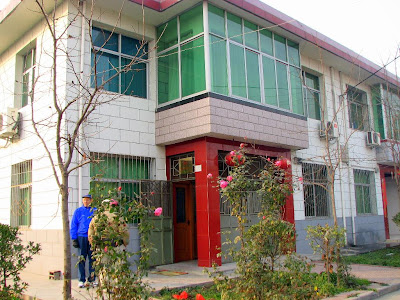
Day 15 - Yangtze River Cruise
Thursday November 29
Three Gorges Dam
After dinner Wednesday we proceeded to the boat dock to board our cruise boat “Katarina” of the Victoria Cruise Lines. As we walked up the gangplank we were greeted by a Chinese band playing “Suwannee River”, or as it is commonly known “Old Folks at Home”. Our rooms are very nice. Every room has a private balcony where we can sit and watch the view, or hang our laundry. Our room is on the 2nd of 4 levels. There are no elevators. In China unless a structure is more than 10 stories tall they are not required to have an elevator. The ship can accommodate 200 passengers. On our cruise there are 50 Americans and 100 Orientals.

Victoria Katarina (in background)
There is a lot of river traffic and it is non-stop. Keith and I enjoy listening to the passing river barges, tankers and fishing boats through the night.
This cruise, and the Three Gorges Dam, is the highlight of the trip for Keith! (He who writes the daily journal entry calls the ratings for the day.)
Our room was something of a surprise, of the good kind. It is definitely more than we expected; better than Holland American. The only bummer is twin beds. They could be shoved together, but that would block the door the balcony, and then where would we hang our laundry? All room lights are controlled from the bed There is the usual doorway key holder that disables all electricity in the room, including the camera battery charger plugged into the wall outlet. We saw the bellboy use a piece of plastic in the card switch. We know that trick! There is enough room for all our suitcases (which are reproducing), TV, refrigerator, nice size closet opposite a compact but perfectly functional bathroom. There is plenty of hot water and also a sink for shaving, brushing teeth, and doing laundry.
 Typical Standard Stateroom
Typical Standard Stateroom
 Victoria Katarina Dining Room
Victoria Katarina Dining Room
Our departure city was just downstream of the first, and longest of the three gorges. We remained tied up at the dock the night of boarding, then departed early the next morning. Our first pause was to lock through the Gezhouba dam, about one quarter the size of the Three Gorges dam, and built in the late 1980’s as practice.
 Early Morning in the Gezhouba Dam Lock
Early Morning in the Gezhouba Dam Lock
 Exiting the Gezhouba Dam Lock
Exiting the Gezhouba Dam Lock
Shortly after locking through, we approached the Xiling gorge, site of the three gorges dam. The dam was built here because of a granite outcropping, which provided a secure foundation. Most of the area is limestone, which is to porous, permeable, and soft to provide a secure footing for such a gigantic structure.
Before transiting the Three Gorges dam, we docked downstream for a two hour tour of the dam. We viewed the dam and locks from strategically located viewpoints, but were not permitted on or structure, as can be done at Hoover (Boulder) Dam. The security check was a sham. Exit the bus, go through security, then back on the bus. Leave everything on the bus. What’s wrong with this picture?

Three Gorges Dam Diorama
 Three Gorges Dam Fog
Three Gorges Dam Fog
The Yangtze is the third longest river in the world, behind the Nile and the Amazon. Three Gorges is said to be the largest dam in the world, based on concrete volume. It impounds the third largest reservoir. Whatever the numbers, the dam is an impressive structure.
We were told the dam was built primarily for flood control, but it also generates gobs of electricity. The reservoir is about 80% filled. When filled completely, the depth of water at the foot of the dam will be 574ft. There are five locks, the uppermost of which is not yet in use because the reservoir is not full. It took us about 2 hours to lock through. Unfortunately, our photo opportunities at the dam were hampered by fog. The fog persisted off an on throughout our voyage. The fog did not diminish the awesomeness of the canyon scenery, but it did diminish the brilliance of our photos.

Three Gorges Locks Display Poster

Three Gorges Locks Foggy Reality
 Three Gorges Dam Fourth Lock
Three Gorges Dam Fourth Lock
 Coal Is Mined Along the Yangtze
Coal Is Mined Along the Yangtze
The balance of the first gorge, above the dam, is more impressive than the lower part, despite the elevated water level. Inundation has done nothing to diminish the natural beauty. There are steep, rugged mountains on both sides. This area reminds Keith of Gates of the Mountains area on the Missouri River in Montana, except for the heavily populated mountainsides. Keith would like to have seen the river before the dam was built, but boat navigation was very dangerous then, with many shoals, rapids, and rocks. It is much nicer now. Some riverside photos follow.

Yangtze Riverside Homes

Terraced Farming along the Yangtze
 Steep Hillside Farming on the Yangtze
Steep Hillside Farming on the Yangtze
 Shipbuilding on the Yangtze
Shipbuilding on the Yangtze
Food on the boat is sort of Chinese and sort of American. The boat is owned by an American company, and caters to both western and oriental tastes. Lunch was followed by an afternoon on the internet. Internet on the boat costs 100 Yuan (about $15) to rent an air card for the entire trip. It is surprising how well the air card works in this remote (but heavily populated) area. Very slow, and somewhat glitchy, but it’s there. George (our tour guide) says China Telcom is the largest cell phone provider in the world, with over 400 million customers. Everybody seems to have cell phones, including the poorest appearing peasants.
We attended a 4:30pm lecture on the Yangtze River. It was a slick Power Point presentation by a slick young Chinese lady, who spoke barely understandable Chinglish. The lecture stressed the flood control benefits of the dam. We were told that the number of people displaced by the rising waters is less than the number killed in the disastrous 1954 and 1998 floods of the lower Yangtze. According to Wikipedia, over 33,00 people were killed in the 1954 floods.
Keith crashed late in the lecture and went up to the room for a nap before dinner. Keith is coming down with a cold. We have had only one seriously ill member of our tour group. She had a very bad stomach ache for about two days, but she is feeling better now.
6:15 pm was a captain’s reception, where we met a delightful couple from Mississippi , just north of Biloxi . He was a QC engineer at the local shipyard, so he and Keith swapped shop talk for awhile. We also spoke about how much we enjoyed the nearby Alabama Gulf Coast.
Dinner was at 7, followed by a fashion show of ancient and modern Chinese fashions, which we skipped in favor of early retirement. We were docked every night, so we didn't miss any of the spectacular scenery in the dark.
We were usally rafted with othe boats. Sometimes our room was on the outside, facing the open river, and sometmes it faced a freighter. We were told to lock our balcony door the nights we faced workboats.
Typical Docking Facilities
Here are a couple of random observations. The Chinese buoy system is different from US. Forget red right returning. In China , red markers are on the south side of the river, white on the north. Both day marks and floating buoys are used. Floating buoys are placed on a small sampan, and are shaped like a pyramid about 4 feet in height. Red marks are lighted red at night, white are lighted green. Keith has seen no ranges, but then he hasn’t been looking all that carefully. Numerous small fishing boats ply the river at night with no lights. Scary!
 Red to the South, White to the North Bank
Red to the South, White to the North Bank
A word about corruption. As observed by the recently appointed Chairman of the Chinese Communist Party, corruption is one of the no. 1 problems in China . Chinese call many construction projects “tofu construction”, to denote the very poor construction quality.
Another no. 1 problem is pollution, which is everywhere. Air quality in the cities sucks. Most heating and power generation uses coal. This is one of the reasons for the strong emphasis on hydro, as a solution to coal fired power. As seen in many of our photographs, smog is everywhere in China. Keith asked our Shanghai tour guide why there isn’t more emphasis on nuclear power, to cut pollution. The guide replied that they don’t have the technology. Keith then asked why they don’t buy it from the French, who seem to have mastered nuclear power. The guide shrugged his shoulders.
Tomorrow we debark for a four hour tour of a side canyon. Stay tuned.

 Sunrise over the Yangtze
Sunrise over the Yangtze Daning River Excursion Boat
Daning River Excursion Boat 




 Ba Casket
Ba Casket





 Typical Standard Stateroom
Typical Standard Stateroom  Victoria Katarina Dining Room
Victoria Katarina Dining Room Early Morning in the Gezhouba Dam Lock
Early Morning in the Gezhouba Dam Lock  Exiting the Gezhouba Dam Lock
Exiting the Gezhouba Dam Lock
 Three Gorges Dam Fog
Three Gorges Dam Fog

 Three Gorges Dam Fourth Lock
Three Gorges Dam Fourth Lock Coal Is Mined Along the Yangtze
Coal Is Mined Along the Yangtze

 Steep Hillside Farming on the Yangtze
Steep Hillside Farming on the Yangtze  Shipbuilding on the Yangtze
Shipbuilding on the Yangtze
 Red to the South, White to the North Bank
Red to the South, White to the North Bank


 The Truck Zone
The Truck Zone

 Intrepid City Wall Defenders
Intrepid City Wall Defenders Monoclinic Sodium Aluminum Silicate Craftsman
Monoclinic Sodium Aluminum Silicate Craftsman A Happy Chinese Schoolroom
A Happy Chinese Schoolroom  Student Artist
Student Artist Teacher’s Sanitary Facility
Teacher’s Sanitary Facility



 Traditional Chinese Pillow
Traditional Chinese Pillow
 George Demonstrates His Childhood
George Demonstrates His Childhood The Kitchen Sink
The Kitchen Sink
 Venue of Our Home Stay in the New Village
Venue of Our Home Stay in the New Village The Living Room
The Living Room Our Host’s Mother Prepares Dinner
Our Host’s Mother Prepares Dinner  Our Home Stay Sleeping Quarters
Our Home Stay Sleeping Quarters